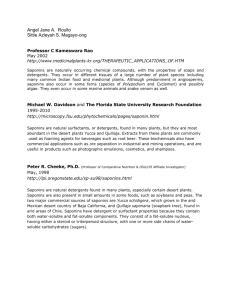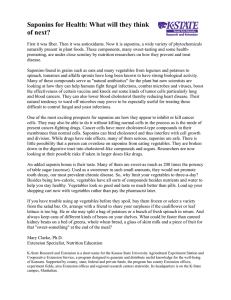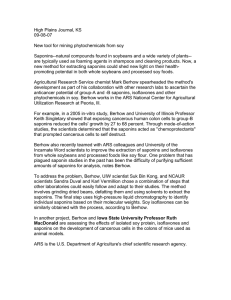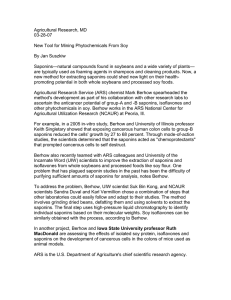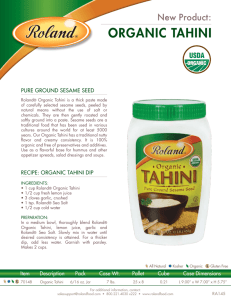Advance Journal of Food Science and Technology 2(2): 109-115, 2010
advertisement
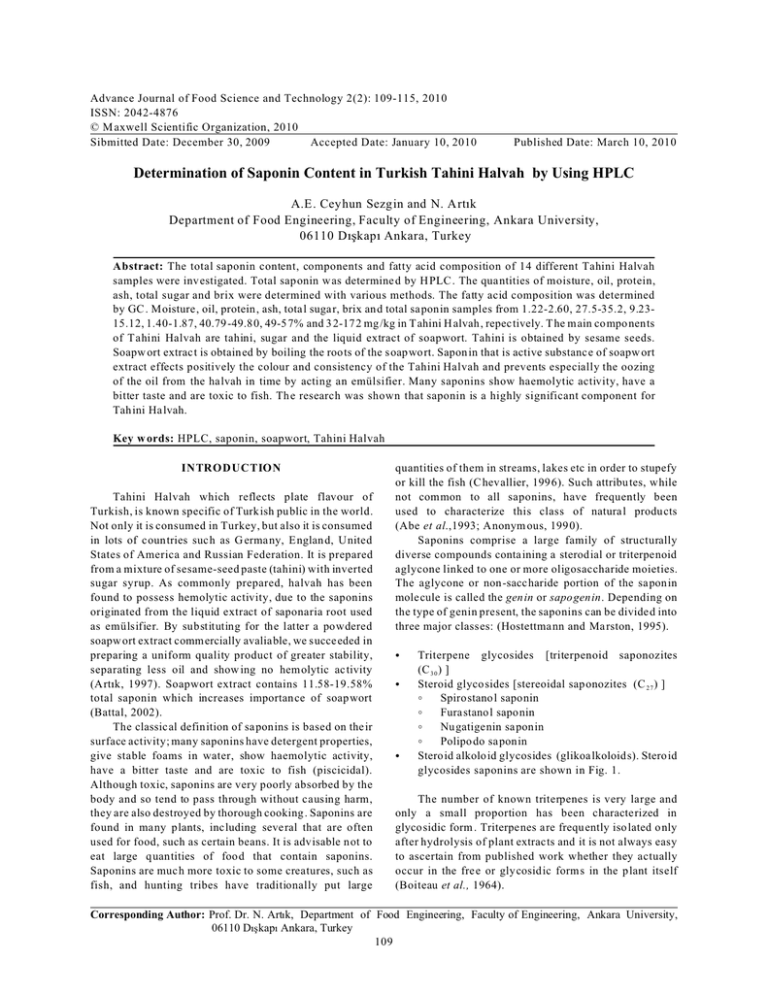
Advance Journal of Food Science and Technology 2(2): 109-115, 2010 ISSN: 2042-4876 © M axwell Scientific Organization, 2010 Sibmitted Date: December 30, 2009 Accepted Date: January 10, 2010 Published Date: March 10, 2010 Determination of Saponin Content in Turkish Tahini Halvah by Using HPLC A.E. Ceyhun Sezgin and N. Art2k Department of Food Engineering, Faculty of Engineering, Ankara University, 06110 D2Õkap2 Ankara, Turkey Abstract: The total saponin content, components and fatty acid composition of 14 different Tahini Halvah samples were investigated. Total saponin w as determine d by H PLC . The qua ntities of moisture, oil, protein, ash, total sugar and brix were determined with various methods. The fatty acid composition was determined by GC . Moisture, oil, protein, ash, total sugar, brix and total saponin samples from 1.22-2.60, 27.5-35.2, 9.2315.12, 1.40-1.87, 40.79 -49.80, 49-5 7% and 3 2-172 mg /kg in T ahini H alvah , repectively. The m ain compo nents of Tahini Halvah are tahini, sugar and the liquid extract of soapwort. Tahini is obtained by sesame seeds. Soapw ort extract is obtained by boiling the roots of the soapwort. Sapon in that is active substance of soapw ort extract effects positively the colour and consistency of the Tahini Halvah and prevents especially the oozing of the oil from the halvah in time by acting an emülsifier. Many saponins show haemolytic activity, have a bitter taste and are toxic to fish. Th e research was shown that saponin is a highly significant component for Tahini Ha lvah. Key w ords: HPLC, saponin, soapwort, Tahini Halvah INTRODUCTION Tahini Halvah which reflects plate flavour of Turkish, is known specific of Turkish public in the world. Not only it is consumed in Turkey, but also it is consumed in lots of countries such as G erma ny, Englan d, United States of America and Russian Federation. It is prepared from a mixture of sesame-seed paste (tahini) with inverted sugar syrup. As commonly prepared, halvah has been found to possess hemolytic activity, due to the saponins originated from the liquid extract of saponaria root used as emülsifier. By substituting for the latter a powdered soapw ort extract commercially avaliable, we succe eded in preparing a uniform quality product of greater stability, separating less oil and show ing no hem olytic ac tivity (Art2k, 1997). Soapwort extract contains 11.58-19.58% total saponin which increases importance of soapwort (Battal, 2002). The classical definition of saponins is based on their surface activity; many saponins have detergent properties, give stable foams in water, show haemolytic activity, have a bitter taste and are toxic to fish (piscicidal). Although toxic, saponins are very poorly absorbed by the body and so tend to pass through without causing harm, they are also destroyed by thorough cooking . Saponins are found in many plants, including several that are often used for food, such as certain beans. It is advisable n ot to eat large quantities of food that contain saponins. Saponins are much more toxic to some creatures, such as fish, and hunting tribes have traditionally put large quantities of them in streams, lakes etc in order to stupefy or kill the fish (C hevallier, 199 6). Such attribu tes, while not common to all saponins, have frequently been used to characterize this class of natural produ cts (Abe et al.,1993; Anonym ous, 1990). Saponins comprise a large family of structurally diverse compounds containing a sterodial or triterpenoid aglycone linked to one or more oligosaccharide moieties. The aglycone or non-saccharide portion of the sa ponin molecule is called the genin or sapo genin. Depending on the type of genin present, the saponins can be divided into three major classes: (Hostettma nn and Ma rston, 1995). C C C Triterpene glycosides [triterpenoid saponozites (C 3 0 ) ] Steroid glycosides [stereoidal saponozites (C 2 7 ) ] B Spirostanol saponin B Furastanol saponin B Nugatigenin saponin B Polipo do saponin Steroid alkoloid glycosides (glikoalkoloids). Steroid glycosides saponins are shown in Fig. 1. The number of known triterpenes is very large and only a small proportion has been characterized in glyco sidic form . Triterpenes are frequ ently iso lated only after hydrolysis of plant extracts and it is not always easy to ascertain from published work whether they actually occur in the free or glycosidic forms in the p lant itself (Boiteau et al., 1964). Corresponding Author: Prof. Dr. N. Art2k, Department of Food Engineering, Faculty of Engineering, Ankara University, 06110 D2Õ kap2 Ankara, Turkey 109 Adv. J. Food Sci. Technol., 2(2): 109-115, 2010 an acid moiety is esterified to the aglycone, the term ester sapo nin is often used for the respective glycosides. All saponins have in common the attachment of one or more sugar chains to the aglyco ne. M onodesmosidic saponins have a single sugar chain, norm ally attached at C-3. Bide smosidic saponins have two sugar chains, often with one attached through an ether linkage at C-3 and one attached throug h an ester linkage at C-28 (triterpene saponins) or an ether linkage at C-26 (furostanol saponins). Tridesmosidic saponins have three sugar chains and are seldom fo und. Bidesmosidic saponins are e asily transformed into monodesm osidic saponins by, for example; hydrolysis o f the esterified sug ar at C-28 in triterpene saponins; the y lack man y of the characteristic properties and activities of monodesm osidic saponins (Hostettma nn and Ma rston, 1995). A brief biosynthesis summary of triterpenes and steroids is show n in Fig . 2. They are built up of six isoprene units and have a com mon biosynthetic origin in that they are all derived from squalene, presum ably v ia ring opening of squalene-2,3-epoxide, followed by a concerted cyclization. It is only recently that the corresponding cyclases have been characterized (Abe et al.,1993). While the true triterpenes have 30 carbon atoms, the steroids have only 27 carbons by virtue of the oxidative cleavage of three methyl groups from a C 3 0 intermediate (Heftmann, 196 8). Sapon ins are extremely widely distributed in the plant king dom . It is known that over 90 families contain sap onins. A systematic investigation of 1730 central Asian plant species, that 76% o f the families contained saponins. Saponins occur in plants which are used as human food; soybeans, chick peas, peanuts, lentils, spinach, oats, garlic, sugar beet, patotoes, green peppers, tomatoes, oins and tea (Birk and Peri, 1980; Oa kenfull, 1981; Price et al., 1987). In leaf cells o f sugar beet and root cells of the pea plant, the triterpene glycosides are present mainly in a bound from, with the hig hest co ncentration occurin g in the chloroplasts and mitochondria. The fact that saponins are localized in organells which h ave a high m etabo lic turnover rate implies that they are not simply balast material but may be important regulatory substances in the metabolism and development of an organism, i.e. they may be physiologically significant constituents (Anisimov and Chirva, 1980). Generalizations about the solubilites of saponins are hazardous but many are soluble in water (particularly if the water contains small amounts of alkali) and alcohol; some are soluble in ether, chloroform, benzene, ethyl acetate or glacial acetic acid. The amp hiphilic nature of saponins dominates their physical properties in solution. They are strongly surface active, form stable foams, act as emulsifying agents and form micelles in much the same way as detergents (Hostettma nn and Ma rston, 1995). Fig. 1: Steroid glycosides saponins The agylcones are normally hydroxylated at C-3 and certain methyl groups are frequently oxidized to hydroxm ethyl, aldehyde or carboxyl functionalities. W hen 110 Adv. J. Food Sci. Technol., 2(2): 109-115, 2010 Asetic acid Mevalo nic acid Farnesil Pirofosfat Squalen Fig. 2: Biosynthesis of triterpenes and steroids Legume s, peas and soybeans, also co ntain sm all quantities of saponins, which are proving their worthiness as phytoche micals. In the diet, phytoche mical saponins have a wide spectrum of activity as antifungal and antibacterial agents, lowering of blood cholesterol and inhibition of cancer cell growth. Recent studies have suggested that the low serum cholesterol levels of Masai tribes in East Africa - who con sume a diet very high in animal products, cholesterol, and saturated fat – are probably due to the consumption of saponin - rich herbs. Saponin act by bindin g with bile acids a nd ch olestero l, so it is thougth that these chemicals “clean” or purge these fatty compounds from the body, lowering the blood cholesterol levels. Sapon in content dep ends on factors such as the cultivar, the age, the physiological state and the geographical location of the plant. There can be considerable variation in composition and quantity of saponins in vegetable material from different places (Kawai et al., 1988). Different methods have been employed for the qua litative an d qu antitativ e determ ination of saponins: haemolysis, piscicidal activity, gravimetry, spectrophotometry, TLC, GC, HPLC (Hiller and Voigh t, 1977; Hiller et al., 1966; Price et al., 1987). The ability of saponins to cause haemolysis of blood in vitro. Low concentrations of saponins are capable of destroying erythrocyte membranes, causing a release of haemoglobin. The phenomenon involves a reduction of surface tension between the aqueous and lipid phases of erythro cyte membrane, causing emulsion of the lipids and their subsequent departure from the membrane. Through these holes Na+ and water are allowed to enter the ce ll, while K + leaves. This flux occurs until the memrane 111 Adv. J. Food Sci. Technol., 2(2): 109-115, 2010 ruptures and haemoglobin is shed into the plasma (Hostettmann and Marston, 1995). Hae moly tic activity varies considerably with the structure of the glycoside. Monodesm odidic steroids and triterpene sa ponins are strong ly haem olytic but bidesmosidic furostanol saponins and triterpene bidesmosides are virtually inactive (Romussi et al., 1980). Many saponins have a reputation for being bitter. The seed-coat of quinoa (Chenopodium quinoa, Chenopodiaceae) for example contains bitter saponins which have to be removed before cooking (Mizui et al., 1988). The saponins in the Tahini Halvah and soapwort have been studied by several author (Battal, 2002; Baylan, 1990). Baylan (1990) reported that concentration of sapo nin ranged between 119-266 mg/kg in Tahini Halvah. Determination of saponin by TLC method. Battal (2002) reported that concen tration of saponin 1 1.58-19.58% in extracts of soapwort. So, aim of the present study was to determine the proximate composition and quantitative of saponin in the Turkish Tahini Halvah. Fig. 3: A typical HPLC chromatogram of standart saponin (Gylcyrrhizic acid) equivalent prior to analyses (Hurst et al., 1983). Before enjection to HPLC column, extracts were filtered though a 0.45 :m membrane fitler (Millipore, Bedford, USA) and analy zed b y HPLC . MATERIALS AND METHODS Standard: Five m illigrams of glycyrrhizic acid ammonium salt was weighed into a 100 m L volumetric flask and diluted to volume with LC water for final concentration of 0.05 mg/m l for using saponin standard. The chromatogram of standart saponin (Gylcyrrhizic acid) is shown in Fig. 3. This study w as led to the Laboratory of A nkara University, Engineering Faculty, Food Engineering Departm ent in T urkey. Sam ples: Fourteen different Tahini Halvah samples from producer firm or market were used for determination of total saponin an d othe r com ponents. Tahini Halvah samples were stored in glass jar and kept at 20ºC in laboratory. HPLC analysis: Chromatographic analyses were carried out on an the HPLC system (Shimadzu, Kyoto, Japan) that cosisted of a L C-10 AD-V P gradient pump , a Rheodyne 7125 i valve furnished with 20 :L loop, a SPDM10A photodiode array detector, CTO-10AS column oven, DGU -14A degasser and a SCL-10A system controller. Seperation of saponins was carried out using an Nucleosil Macherey-N agel C1 8 (250 x 4 .6 mm ID, particle size 5 :m) column (Barcelona, Spain) at 1.5 ml min G 1 flow rate. Detection was made at 254 nm and 25ºC . The HPLC mobile phase consisted of methanol, water and acetic ac id in the ra tio of 60/34/6 (v /v/v). The mobile was filtered and degassed prior to use. The compounds appering in chromotograms were identified on retention times and sp ectral data by com parasion w ith standards. All analyses were done on duplicate in each sample. Chem icals and reagents: Methanol (HPLC grade ), asetic asit (HPLC grade ), analytic grade NH 4 OH , H 3 PO 4 , CH 3 OH and diastase were purchased from Merck (Darmstadt, Germ any) Stand art of Gylcyrrhizic acid were purchased from Sigma - Aldrich Co. (St. Louis, MO, USA ). M ethods: Extraction procedure for HPLC: All samp les were ground in a mill or blender and extracted according to the following procedure. Two grams of Tahini Halvah was we ighed to a 100 mL blender cup of a mixer. Approximately 30 mL of water (90-95ºC) and 2 ml of concentrated NH 4 OH (37%) were added, and the con tents were blended for 3 min. The resulting solution was quantitatively transferred to a 150 mL beaker. The pH of the solution was adjusted to a pH of 7.0 with H 3 PO 4 and 1 ml of 10% diastase was adde d. This was incubated at 37ºC for 30 m in, cooled to room temperature, and transferred to a 100 mL volum etric flask with CH 3 OH. The final extract was diluted to volume with additional CH 3 OH and filtered through Whatman No. 42 paper or Moisture: Moisture content was determ ination in vacuum at 70ºC tem perature of etuve (Regn ell, 1976). Crude Fat: Soxhelet method was used for determination of crude fat con tent in Tahini H alvah (Jam es, 1995). Protein: Total protein was determined by Kjeldahl method. The factor of 6.25 is used for estimation of total protein (An onym ous, 1997). 112 Adv. J. Food Sci. Technol., 2(2): 109-115, 2010 Table 1: Levels of moisture, oil, protein, ash, brix and total sugar in 14 individual samples of Tahini Halvah No. of smples M o is tu re % ) C ru de fa t (% ) P ro te in (% ) A sh (% ) 1 1.72 33.26 9.23 1.44 2 2.04 31.46 9.49 1.48 3 1.48 32.25 12.47 1.42 4 1.32 30.45 12.51 1.41 5 1.22 33.15 15.05 1.87 6 1.35 31.30 12.25 1.40 7 1.41 34.50 12.43 1.85 8 2.15 31.85 11.03 1.65 9 2.60 27.50 15.12 1.83 10 1.24 35.20 11.25 1.72 11 1.40 32.40 12.25 1.72 12 1.38 31.90 12.99 1.73 13 1.54 32.90 12.95 1.69 14 1.61 33.00 13.22 1.68 Table 2: Fatty Acids composition of 14 individual samples of Tahini Halvah No. of samples P alm itic ac id (% ) S te aric ac id (% ) le ic ac id (% ) 1 10.425 5.471 43.015 2 12.697 6.928 42.673 3 11.198 3.841 35.125 4 10.009 5.833 42.706 5 10.722 4.475 38.231 6 12.253 6.983 38.228 7 11.447 5.278 40.305 8 10.028 5.623 42.324 9 9.434 5.544 40.817 10 10.843 4.886 39.317 11 10.158 5.187 40.203 12 10.214 5.662 43.975 13 10.234 5.994 40.987 14 10.675 3.612 41.921 B rix (% ) 49 57 55 57 49 50 53 53 54 52 56 54 52 52 L in ole ic ac id (% ) 40.668 37.477 49.475 41.214 46.341 42.300 42.701 41.785 43.880 44.725 44.240 39.904 42.542 43.541 T ota l s ug ar (% ) 43.47 49.77 48.80 49.80 40.79 42.16 47.57 47.50 48.98 46.39 49.60 48.80 46.02 47.51 L in ole nic ac id (% ) 0.421 0.225 0.361 0.238 0.231 0.236 0.269 0.240 0.325 0.229 0.212 0.245 0.243 0.251 Ash: Tah ini halvah samples were set on fire at 550 ± 20ºC in ash oven (Anon ymou s, 1968). Total and reducing sug ars: Total and reducing sugars were determined by the Lane -Eynon m ethod (C emerolu, 1992). Soluble solids (Brix): Soluble solids (%) w ere measured by using a Bausch - Lom b refractome ter at 20°C (R egnell, 1976). Fatty acids composition: GC instrum ent w as use d fatty acids com positio n of T ahini H alvah sam ples (Anonymo us, 1990). RESULTS AND DISCUSSION Fig. 4: A typical chromatogram of fatty acids in Tahini Halvah Some analytical properties of 14 different Tahini Halvah samples are given Table 1. For Tahini Halvah; moisture content 1.22 -2.60%, o il content 27.5-35.2%, protein content 9.23-15.12%, ash content 1.40-1.87%, total sugar 40.79-49.80% and brix 49-57% were determ ined in this study. Fatty acids composition of 14 individual Tahini Halvah samples are given Table 2. Tahini H alvah oil is predomin antly mad e up o f linoleic (37.47 -49.47% ), oleic (35.12-43.97% ), palmitic (9.43-1 2.69%), stearic (3 .6 1-6 .9 8% ) and linolenic (0.21-0.42 %) a cids respectively. The linoleic acid must be min 32% , oleic acid must be min 35% , palmitic acid must be min 7% and linolenic acid must be max 2% in the standart of Tahini Halvah TS 2590 (Anonymous, 1998). The results obtained were in unison with standart of Tahini Halvah TS 2590 in Turkey. A typical chromatogram of fatty acids in Tahini Halvah is shown in Fig. 4. 113 Adv. J. Food Sci. Technol., 2(2): 109-115, 2010 Table 3: Levels of saponin in 14 individual samples of Tahini Halvah No. Of samples Saponin (ppm) S ap on in (% ) 1 32 0.0032 2 76 0.0076 3 68 0.0068 4 96 0.0096 5 44 0.0044 6 48 0.0048 7 65 0.0065 8 84 0.0084 9 36 0.0036 10 163 0.0163 11 172 0.0172 12 148 0.0148 13 112 0.0112 14 104 0.0104 W e determined that proportion ratio of total saponin renged from 32 to 172 mg/kg. Saponin concentration of Tahini Halvah samples are given Table 3. The chromatograms illustrating saponin in Tah ini Halvah are shown in Fig. 5 and 6. B aylan (199 0) determined total sapo nin of Tahini Halvah by TLC and it was reported total saponin content of Tahini Halvah as 119-266 mg/kg. Turkish Stand ard (TS 2590) is standart of Tahini Halvah in Turkey an d total saponin level must be max 0.1 % in Tahini Halvah. These studies are harmanious for Turkish Stand ard (TS 2590) (A nonymo us, 1998). CONCLUSION The results of present study demonstrated that sapo nin is a significant component for Tahini Halvah. The liquid extract of soapw ort is used as a food additive in the preparation of Tahini Halvah. Saponin that is active substance of soapwort extract effects positively the colour and consistency of the halvah and prevents especially the oozing of the oil from the halvah in time by acting an emülsifier. Sesame and sugar may affect total sa ponin level of Tahini Halvah . Because both o f them contain saponin. Sapon in may be carried to Tahini Halvah from sesame or sugar. So this level can be determined differen tly in samples. Also the halvah producer use different concen tration of soapw aort exctract for Tahini Halvah. Thus total saponin level may be determined differently. HPLC technique is rapid, accurate and precise. Additionally, for those laboratories that do not possess an HPLC , the spe ctroph otom etric method, w hile not as fast, serves as a good alternative for analysis of saponin content in Tahini Halvah. Fig. 5: A typical HPLC chromatogram of saponin in Tahini Halvah REFERENCES Abe, I., M. Rohmer and G.D. Prestwich, 1993. Enzym atic cyclization of squalene and oxido squa lene to sterols and triterpenes. Chem. Rev., 93: 2189-2206. Anisimov, M. and V.C. Chirva, 1980. Die biologische Bewertung von triterpenglycoside. Pharmazie, 35: 731-738. Anony mous, 1968. Laboratory Manual for Food corners and Processors. Vol: 2. The Avi Publishing Co, W estport, conn. Anony mous, 1990. Fatty Acids in Oils and Fats. AOAC Official Methods of A nalysis, 15th Edn., K. Helrich, (Ed.), 2: 963-964. Anony mous, 1997. Official Methods of Analysis of AOA C International on CD-RO M.16th Edn. Anonymous, 1998. Standart of Turkish Tahini Halvah. T.S. 2590. Institute of Turkish Standarts, Ankara, Turkey. pp: 10. Art2k, N., 1997. Traditional foods in Turkey. The Research Institute for Food Science. The Bulletin of Kyoto University, pp: 51. Fig. 6: A typical HPLC chromatogram of saponin in Tahini Halvah Battal (2002) has reported that total saponin was 11.58-19.58% in soapw ort excract. Total saponin content in different soapworts were determined by HPLC. Battal (2002) has also reported regarding saponin yield, optimal extraction time was 8 hours. 114 Adv. J. Food Sci. Technol., 2(2): 109-115, 2010 Battal, H., 2002. A research on the production of soapw ort extract. Ankara University Graduate School of Natural and Applied Sciences. Department of Food Engineering. M aster Thesis. A nkara, Tu rkey, pp: 44 . Baylan, N., 19 90. R esearch on the sap onin c onten t in Tahini Halvahs. Ankara University Graduate School of Natural and Applied Sciences. Department of Food Engineering. Master Thesis. Ankara, Turkey, pp: 64. Birk, Y. and I. Peri, 1980. Saponins. In: Liener, I.E. (Ed.), Tox ic Constituents of Plan t Food-stuffs. 2nd E dn., Academic Press, New Y ork, 1: 161-182. Boiteau, P., B. Pasich and R.A. Rakoto, 1964. Les Triterpenoides en Physiologie Vegetale et Animale. Gautheier-Villars, Paris. Cem erolu, B., 1992. Ba se A nalysis meth ods o f fruit and vegetab le processing 2ndustry. Biltav Broadcast. Ankara, Turkey, pp: 381. Chevallier, A., 1996. The Encyclopedia of Medicinal Plants Dorling Kindersley. London, ISBN: 9,780751303148. Heftmann, E.,1968. Biosynthesis of plant steroids. Lloydia, 31: 293-317. Hiller, K., M . Keipert, and B. Linzer, 1966. Triterpensaponine. Pharmazie, 21: 713-751. Hiller, K. and G. Voight, 1977. Neue Ergebnisse in der Erforschung der Triterpensaponine. Pharmazie, 32: 365-393. Hostettmann, K. and A. M arston, 1995. Saponins. Chemistry and P harm acolo gy of Natural Products. Cambridge University Press. Avustralia, pp: 584. Hurst, W.J., J.M. M ckim and R.A . Martin, 1983. Highperformance liquid chromatographic determination of glycy rrhizin in licorice products. J. Ag r. Food Chem ., 31: 387-389. James, C.S., 1995. Analytical Chemistry Of Foods. Publisher Blacie Academic and Professional. London, pp: 176. Kawai, H., M. Kuroyanagi, K . Umehara, A. Ueno and M . Satake, 1988. Studies on the saponins of Lonicera japonica THUN B. Chem. Pharm. Bull., 36: 47694775. Mizui, F., R. Kasai, K. Ohtani and O. Tanaka, 1988. Saponins from brans of quin oa, Chenopodium quinoa wiild. I. Chem. Pharm. Bull., 38: 375-377. Oakenfull, D., 1981. Saponin in food-a rewiev. Food Chem., 6: 19-40. Price, K.R., I.T. Johnson and G.R. Fenwick, 1987. The chem istry and biological significance of saponins in foods and feedingstuffs. CR C C rit. Rev. Food Sci. Nutr., 26(1): 27-135. Regnell, C.J., 1976. The analytical methods of processed fruit and vegetable. Publication of Food Control Education and Research Institue of Bursa, 2: 156-160. Romussi, G., S. Caffaggi and G. Bignardi, 1980. Hemoly tic action and surface activity of triterpene saponins from Anchusa officinalis L. Part 2: on the constituents of Boragina ceae. Pharm azie, 35: 498-499. 115
